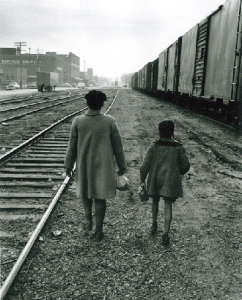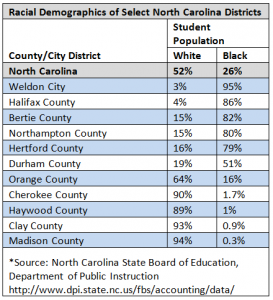 Many have tried to link vouchers and school choice to racism, but it can’t be done without a tortured reading of the law and civil rights history. So it was a surprise to see two civil rights attorneys at an elite American university doing exactly that last week. The attorneys, Elizabeth Haddix and Mark Dorosin of the University of North Carolina Center for Civil Rights, penned “The Ugly Truth About Vouchers,” where they argue vouchers are a tool of modern racism.
Many have tried to link vouchers and school choice to racism, but it can’t be done without a tortured reading of the law and civil rights history. So it was a surprise to see two civil rights attorneys at an elite American university doing exactly that last week. The attorneys, Elizabeth Haddix and Mark Dorosin of the University of North Carolina Center for Civil Rights, penned “The Ugly Truth About Vouchers,” where they argue vouchers are a tool of modern racism.
The authors begin linking school choice to racism by claiming private schools “are permitted to discriminate against students on the basis of race,” which is simply not true. Surely, they know better. As determined by the U.S. Supreme Court in Runyon v. McCrary (1976), no private school in the U.S. is permitted to discriminate based on race, color or national origin.
Next, Haddix and Doroson argue there are “historical links between racism and private schools” and, thus, the attempt to attach vouchers and school choice to the civil rights movement is “a twisted irony.”
Indeed, as they point out, many private schools across the nation grew in enrollment during the era of desegregation, as white students fled public schools that were enrolling black students. But to draw the link between racism and private schools is to miss the more important historical precursor: American public schools were themselves rooted in racism. African-Americans waited 235 years after the founding of the first public high school to get their first public high school. It would be another 84 years before the U.S. Supreme Court ruled on Brown v. Board (1954) and nearly 20 more years before real integration efforts were made.
Don’t forget, public school districts and elected officials fought racial integration every step of the way. While it is true some parents jumped ship to private schools, some areas, such as Poquoson, Va., became their own independent districts, zoning African-Americans completely outside city boundaries. Other districts shut themselves down altogether to avoid integration. Furthermore, many urban areas faced “white flight” as white families segregated themselves into whiter public school enclaves. This segregation in public schools remains largely intact to this day.
After whitewashing this history, the authors point to four rural, North Carolina counties with the highest concentration of black students. Blacks make up 79 to 86 percent of public school enrollment in those counties while private schools there are between 95 and 99 percent white. Whether the authors are correct in their insinuation that racism still motivates private school parents and students, the point they seem intent on missing is that the new voucher plan likely would send many black students to largely white private schools – and thus reduce segregation. How is that racist?
Finally, the authors directly link North Carolina’s recent voucher legislation with racist policies occurring 40-60 years prior. They write, “Private entities that profit from privatizing our tax dollars have not been made to answer for the racist history of their legislation.”
 It is a head-scratching statement given the lingering racial segregation in North Carolina along public school district lines. Though the North Carolina student population is 52 percent white and 26 percent black, districts range from 0.03 percent to 95 percent black and 3 percent to 94 percent white. That’s as bad as, or worse than, the racial makeup of the private schools the authors highlight.
It is a head-scratching statement given the lingering racial segregation in North Carolina along public school district lines. Though the North Carolina student population is 52 percent white and 26 percent black, districts range from 0.03 percent to 95 percent black and 3 percent to 94 percent white. That’s as bad as, or worse than, the racial makeup of the private schools the authors highlight.
Those stark differences often surface in districts right next to each other. Take Orange and Durham counties. Orange County – home of UNC-Chapel Hill – is 64 percent white and 16 percent black. Its neighbor, Durham County, is 19 percent white and 51 percent black.
The authors’ statements are even more disappointing when you realize the great work the UNC Center for Civil Rights has done in highlighting the inequalities facing low-income and minority students. Last year, the center’s report, “The State of Exclusion,” blasted public school zoning policies. “Nor does everyone have equal access to the community’s best schools due to school assignment policies,” it wrote. “Some counties have multiple school districts, a situation which often aggravates disparities based upon spatial segregation.”
The report found “failing schools” were the closest school to 48 percent of all black students in the state, while high-poverty schools were the closest to 68 percent. These rates were double the statewide average for all students.
Given the existing racial and income disparities, the most likely beneficiaries of North Carolina’s voucher program – put on hold last week by a court injunction – are minority students. This is exactly what we saw in Florida after the state passed the Tax Credit Scholarship Program (which is administered by Step Up For Students, co-host of this blog). Today, 70 percent of scholarship students attending private schools are black or Hispanic. Half of the students come from single-parent households, while the average scholarship student lives in a family with a household income just 9 percent above poverty.
Isn’t this exactly the student population Haddix, Dorosin and the UNC Center for Civil Rights wish to help in North Carolina?



Wow…great piece Patrick. Well done sir.
We the parent should have a choice to make sure that no child in North Carolina goes without a education such as my daughter Megan has and continue to for the 2013-2014 public school year. This is from August 26,2013 and continuing on an it 2/28/14 now. My daughter is a 11 year old special needs qualified school age person that our local LEA is depriving of a public school education knowing she is receiving no education at all. The NC State Superintendent June St. Clair Atkinson is up holding the school Wilson County School District, Wilson NC but I say the vouchers are needed because serious educational and other harm has come to my daughter because her education should be consistent and not just when the local LEA chooses to let her attend school.
I’m sorry to hear the situation you and your child are in right now. It is a myth that public schools have to teach every child and I’m sorry to hear you experience that first hand. Some states offer special needs vouchers (which provide more financial support than other voucher programs). Hopefully NC will create one in the very near future.
Throwing around #s about current split of where people in NC live does not in any way address the future of what will possibly happen with vouchers. $4200 doesn’t cover most private school tuition, so how exactly does a poor family make up the difference (as opposed to the rich families who are already being targeted by advertising for these scholarships)? Your argument makes no sense in terms of predicting the future. Putting lots of stats in there doesn’t make it more cogent. Sounds like we’re left with he said/she said, so why did I bother reading this?
Hi James,
We are all in favor of increasing the scholarship amounts. Unfortunately, higher scholarship amounts brings stronger opposition from the very people who raise the same point as you. While NC is offering a small scholarship right now, very few private schools charge tuition that exceeds $10,000 a year. Here in FL, the average private school charges about $7,000 in tuition and fees.
That said, NC’s scholarships were limited to low-income and working-class families so higher income families wouldn’t get the scholarship.
As for the stats, it really isn’t predicting the future (as we’ve seen the same thing in all states offering means tested vouchers/scholarships). Minority students are more likely to be low-income than white students. They are also less likely to be assigned to better public schools and more likely to be assigned to high-poverty schools (UNC Center on Civil Rights research proves this is the case in NC). So we are pretty confident that the bulk of voucher kids will be minorities.Given that most private schools are white, adding more minorities will improve the racial balance and reduce segregation.
Thanks for reading. Please let me know if you have any other questions.